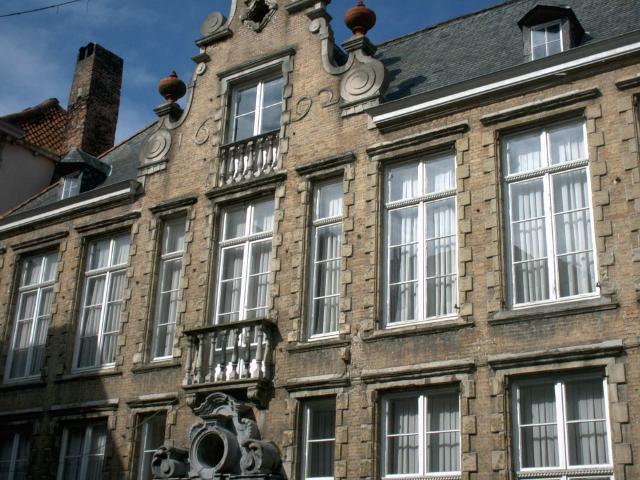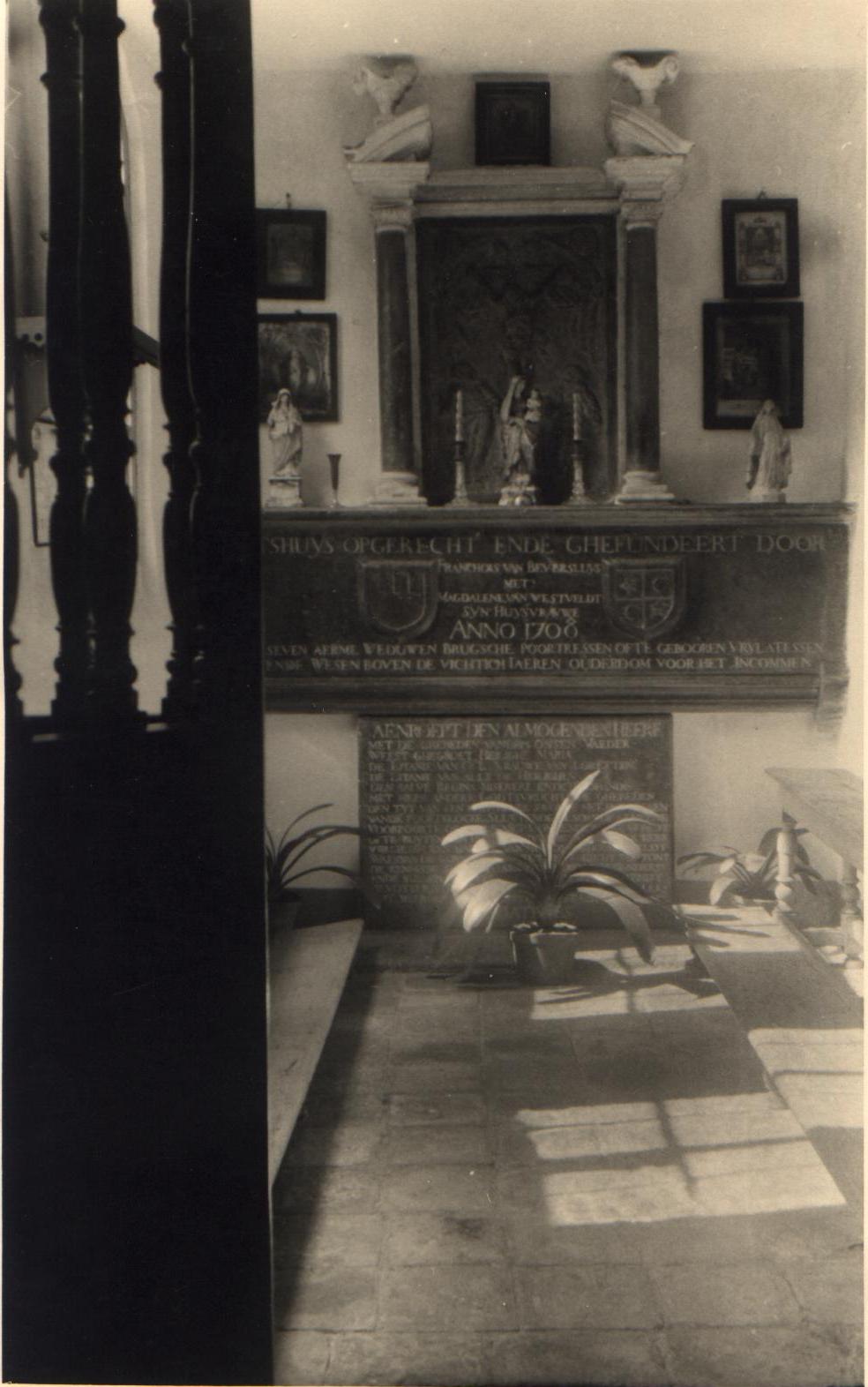Brugge (B.) and the Beversluijs Family.
The Beversluijs family has been significant in the city of
Brugge (Vlaanderen, Belgium), notably around 1700 AD.
At that time Frans van Beversluys (Hoofdontvanger van het
Brugse Vrije) and his wife, Maria-Magdalena van Westveldt
lived in a magnificent "Herenhuis" - dated 1692 - located at
Predikherenstraat 25. This monumental house still exists.

Source: Stadsarchief Brugge, Jan D'hondt, Wetenschappelijk Medewerker:
Over het huis Predikherenstraat 25 is tot nu toe slechts summier onderzoek
gedaan. In 1993 is dit huis opengesteld geweest op de Open Monumenten-
dag. In de gelijknamige brochure is er een bouwfysische beschrijving van dit
huis en enkele gegevens over de opdrachtgever Frans van Beversluys die het
in 1692 heeft doen bouwen.
Hij was behoorde tot de Brugse toplaag en bekleedde functies als
stadstresorier en ontvanger-generaal van het Brugse Vrije. Hij was gehuwd
met Magdalena van Westveldt, die na het overlijden van haar man in 1717
een prachtige stralenmonstrans schonk aan de Onze-Lieve-Vrouwekerk.
Dit echtpaar dat kinderloos stierf stichtte in 1714 het aanpalend gelegen
Godshuis De Pelikaan.(Note: "Het Brugse Vrije" = the Courthouse of Brugge)
A description of this place in French was given as follows:
François van Beversluys qui avait construit une maison
de maître baroque dans la rue des Dominicains en 1692,
aménagea le célèbre hospice « Le Pélican » (1708-1714)
au fond de son jardin, donnant sur le Quai Vert.At the back of their house's garden they endowed a "Godshuis"
which is called "Het Pelikaanhuis" situated on the "Groene Rei"
Source: H. De Bruyne, De Godshuizen in Brugge, Brugge, 1994, p.68-70.
The endowment allows widowed women without financial
means to live the last part of their lives in this house, for which
privilege they are in turn expected to pray for Frans & Maria.

(In part it reads: Gotshuys opgereght ende Ghefundeert door
Franciscus van Beversluys met Magdalena van Westveldt syn
huysvrauwe Anno 1708 .. seven aerme weduwen Brugsche
poortressen ofte gebooren vrijlatessen... ende wesen boven de
vichtich(?) jaeren ouderdom voor het incommen...)So substantial was this donation, that Het Pelikaanhuis still
operates on (the proceeds of) that endowment, I'm told!One document in our possession mentions that Frans van
Beversluys & Magdalena van Westvelt were childless. Frans
died 1717 AD and both are buried in the O.L.Vrouwekerk.De Katte van Beversluys:
In the Onze Lieve Vrouwekerk in Brugge a Treasure by the
name of "De Katte van Beversluys" is kept. It is considered
the most valuable of all of Belgium's monstrances. At 64 cm
height and a weight of 3 Kg with several hundred diamonds
and pearls it represents a significant monetary value, but the
real worth is the work of Art, made by Jan Beaucourt. This
type is called a "stralenmonstrans" or "zonnemonstrans".

Donated to the church in 1725 AD by the Widow Maria-
Magdalena van Westveldt there is a nice - if improbable -
legend to explain this lavish donation.Legend has it the beloved cat of the Widow one day ran off,
bedecked with the equally beloved jewelry of the Widow.
She is supposed to have sworn to donate the jewelry to the
church, if both cat and said jewelry returned safe and whole.
Eight days after her loss, the cat returned with all of the lady's
jewels.Fact is, a notarized document, dated March 20th, 1725,
sets out the donation, sums up the exact amount of pearls,
diamonds, gold necklaces etc. etc., details that Jan Beaucourt
make it into a monstrance - for "400 pond wisselgeldt" - and
that the artwork was supervised by Pieter Massemijn,
Kanunnik van St. Donaas who also received some cash. A
second document (codicil?) was made up detailing the rights
and obligations etc. upon completion & handing over to the
church and shows the signatures of the persons involved!
Nowadays this Church Treasure, a monstrance, is kept out
of the public eye; in fact it has been exhibited only twice, in
1930 and in 1950, both times with Police guards. There is
a full description, published by the "Brugsch Handelsblad" ,
written by Drs. Valentin Vermeersch.
Genealogy notes:
At the time in question we may have several members of the
Beversluys / Beversluijs families living in Brugge. There are
a few inconsistencies however: Franciscus Beversluijs married
Marie Truwers and they had - at least - one son: François.
François was baptised in 1664 and seems to have relocated
to Maastricht and/or Breda between ± 1685 - 1700 AD. He
died in 1712 (in Breda), all of which seems to exclude him
from potentially being the husband of Maria-Magdalena
*or* from constructing the house on the Predikherenstraat
in 1692.
Franciscus, who was married around 1664 seems a more
likely candidate. The first name fits the one on the Altar, the
age seems about right, but we can only guess and assume.If Franciscus had several children and married a second time;
to Maria-Magdalena van Westveldt - the second marriage
remaining childless - then everything we know would seem to
fit.We might find that Bastiaan Beversluijs had a brother, named
Adriaan Beversluijs and that Frans A(driaanszoon) Beversluijs ,
born 1720 in Made (N.Br.) is a greatgrandson of Franciscus.One source states that Franciscus Beversluijs may have
been a son of one Pieter Beversluijs, who may have been
a trader (and) a person of some note in the city of GENT.Recently I was contacted by a descendant of a Pieter
Beversluis, son of Pieter, grandson of Pieter etc. as it
was customary - in that branch of the family - to name
the firstborn son Pieter. This descendant had heard rumors
of an important church treasure in Brugge that was somehow
connected to his ancestors. If Pieter Beversluijs of Gent
can be traced we may then find that Franciscus was a
second (or even later) son?!Last updated: 29-09-2002.